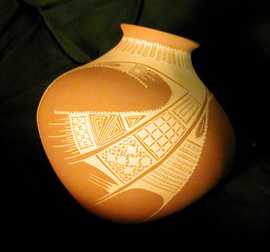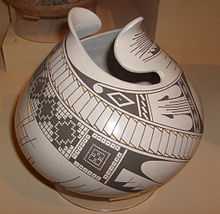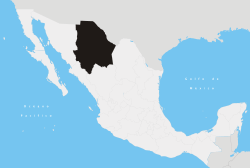Mata Ortiz
Mata Ortiz is a small village in the state of Chihuahua, Mexico, less than 100 miles (160 km) from the US-Mexico border. The community is one of the designated localidades (localities) in the municipio libre (municipality) of Casas Grandes, one of several such pueblos in a wide, fertile valley long inhabited by indigenous people. Mata Ortiz is located at the base of a mountain known as El Indio and on the west bank of the Rio Palanganas, a tributary of the Rio Casas Grandes. The ancient ruins of Casas Grandes are located nearby. As of 2010, Mata Ortiz had a population of 1,182.[1]
Pottery movement
Mata Ortiz has recently seen a revival of an ancient Mesoamerican pottery tradition. Inspired by pottery from the ancient city of Paquimé, which traded as far north as New Mexico and Arizona and throughout northern Mexico, modern potters are producing work for national and international sale. This new artistic movement is due to the efforts of Juan Quezada Celado, the self-taught originator of modern Mata Ortiz pottery, his extended family and neighbors.

Mata Ortiz pots are hand-built without the use of a potter’s wheel. Shaping, polishing and painting the clay is done entirely by hand, often with brushes made from children’s hair. All materials and tools originate from supplies that are readily available locally. The preferred fuel for the low temperature firing is grass-fed cow manure or split wood. Each of these characteristics derive from the ancient pottery traditions of the region, however Mata Ortiz ware incorporates elements of contemporary design and decoration and each potter or pottery family produces distinctive individualized ware.
Young clay workers from surrounding areas have been attracted to the Mata Ortiz revival and have joined Quezada and his associates. New potting families developed and the art movement continues to expand. A vibrant flow of new ideas, without the restraints of traditional practices or gender constraints, has enabled the pottery of Mata Ortiz to avoid derivative repetition common to folk art movements. This blend of cultural expression, economic need and artistic freedom has produced a unique artistic movement in the community.
Reception as an art form
In 1976, anthropologist Spencer MacCallum visited Mata Ortiz and met Juan Quezada and his extended family of brothers, sisters, their children and neighbors. This group of artisans are the core of this now thriving pottery movement. Information published after this and later visits quickly promoted the acceptance of Mata Ortiz pottery as a contemporary art form. This simple pottery is accepted and admired as a legitimate folk art, and has become highly collectable.
Exhibits, displays and demonstrations

An exhibit of 20 pots from Mata Ortiz went on display at the Field Museum of Natural History in Chicago, United States, on July 1, 2005. The exhibit allows visitors to see the different styles of the artists, and includes a short video about the town. The exhibit was on display until May 31, 2006.
The American Museum of Ceramic Art, in Pomona, California, sponsored an exhibit of pottery from Mata Ortiz between June 9 and August 25, 2007. In conjunction with the exhibit, a demonstration workshop on June 10 featured Juan Quezada, his son Noe Quezada, and Diego Valles. Demonstrations included pot formation, decoration and firing methods. There have been various exhibits of Mata Ortiz pottery in Arizona, Colorado, New Mexico and California.
The Mabee-Gerrer Museum of Art in Shawnee, Oklahoma displayed an exhibit of Mata Ortiz Pottery and ancient Casas Grandes work. Shards of Casas Grandes pottery inspired Juan Quezada to create pottery; and the ancient designs deeply influenced his own work. The exhibit, titled Passed to the Present: Prehistoric Casas Grandes and Contemporary Mata Ortiz Pottery Traditions, ran from February 25 to April 3, 2011. The collection was on loan from the Museum of the Red River.[2] [3]
See also
- Native American pottery
References
- ↑ "Casas Grandes". Catálogo de Localidades. Secretaría de Desarrollo Social (SEDESOL). Retrieved 23 April 2014.
- ↑ "Passed to the Present: Prehistoric Casas Grandes and Contemporary Mata Ortiz Pottery Traditions". Retrieved 7 June 2013.
- ↑ "Mata Ortiz Pottery lecture Friday at Mabee-Gerrer Museum of Art". Shawnee News-Star. 9 March 2011. Retrieved 7 June 2013.
Books
- Cahill, Rick. "The Story of Casas Grandes Pottery." Bodjum Books, 1991, ISBN 0-9630853-0-1
- Lowell, Hills, Quintana, et al., The Many Faces of Mata Ortiz, Rio Nuevo Publishers, Tucson, AZ, 1999; ISBN 1-887896-08-2 - an overview of many of the Mata Ortiz potters and their individual styles.
- Parks, Walter, The Miracle of Mata Ortiz, The Courier Press, Riverside, CA, 1994; ISBN 0-9637655-0-7 - outlining the history of Mata Ortiz pottery.
External links
- Mata Ortiz Calendar, maintained by Spencer and Emalie MacCallum. Links to photos of Mata Ortiz pottery, information on travel & tours, news, exhibits and other events related to the village of Mata Ortiz and Mata Ortiz pottery.
- The Story of Mata Ortiz Pottery.
- The Renaissance of Mata Ortiz, documentary on Mata Ortiz pottery.
- Mata Ortiz Pottery: A Forty-Year Phenomenon at the American Museum of Ceramic Art, June 9 - August 25, 2007.
| |||||||||||||||||||||||||
